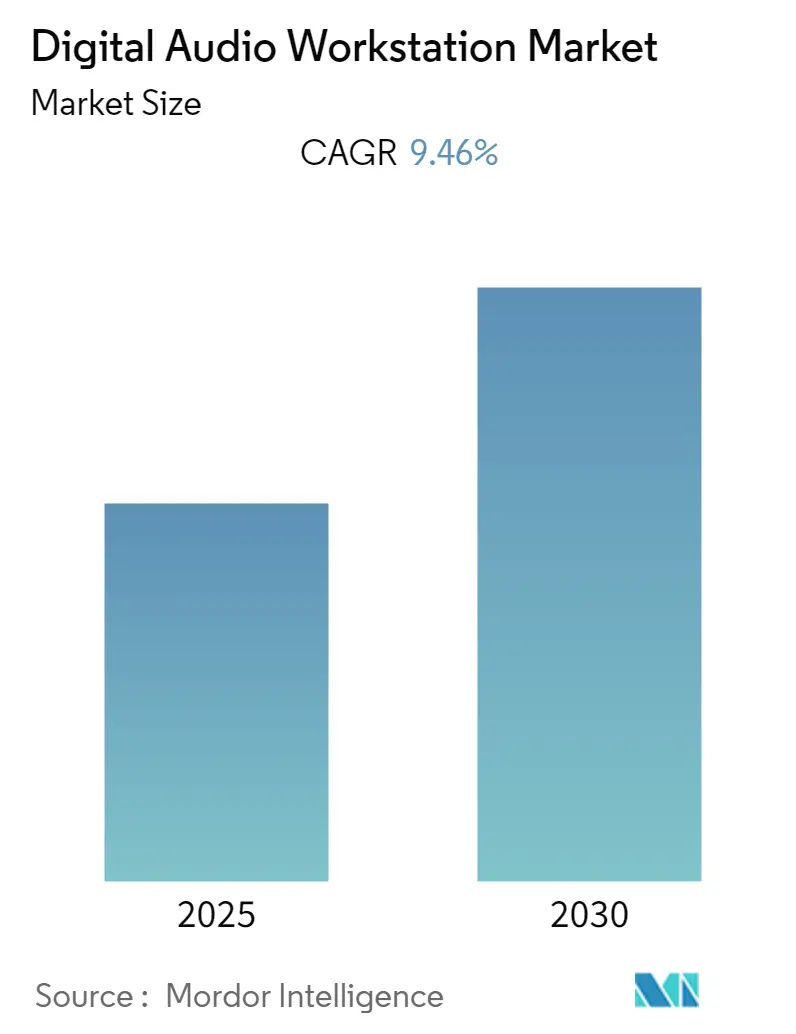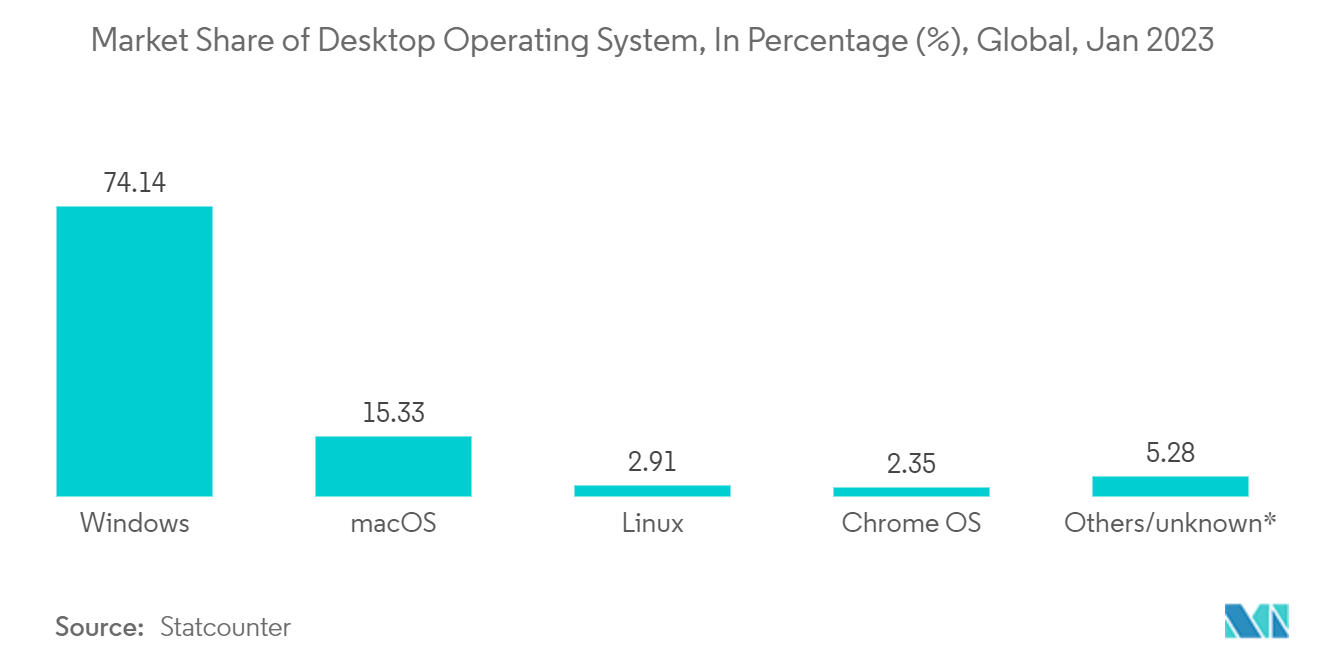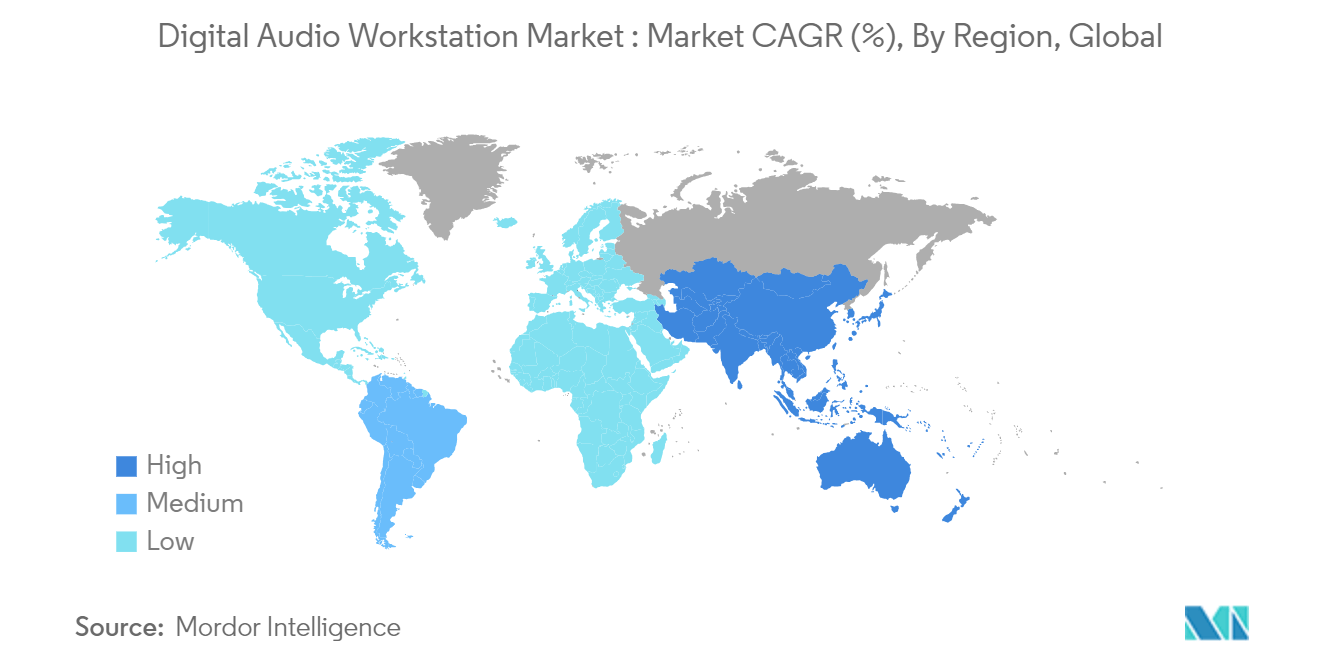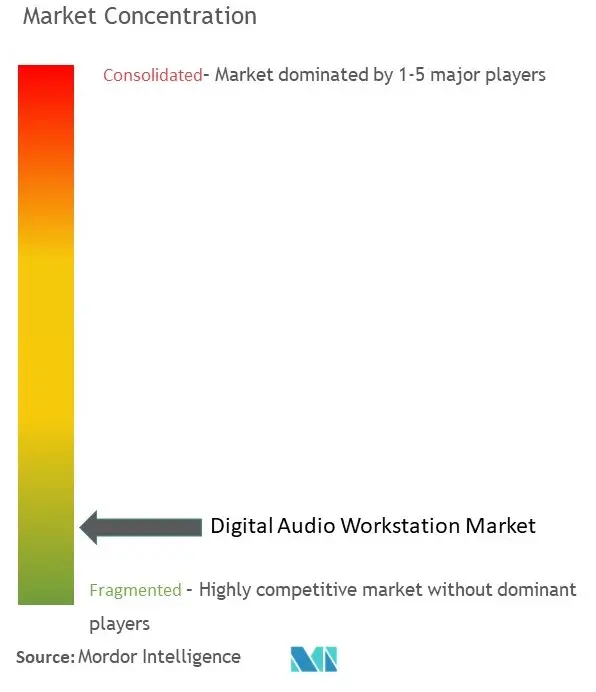Digital Audio Workstations Market Size
Digital Audio Workstations Market Analysis
The Digital Audio Workstation Market is expected to register a CAGR of 9.46% during the forecast period.
Over the past few decades, digital audio workstations have made tremendous progress. In today's entertainment industry, digital audio workstations are used in almost both audio and video processing systems. Digital audio workstation meshwork comprises software and hardware components for recording, editing, mixing, and producing audio files. These are exclusively crafted from silicon carbide or gallium nitride to maintain sound integrity and avoid resonance effects.
- There is a higher adoption of various digital audio workstations due to the technological enhancements in the field of R&D by manufacturers in the market and the entertainment and media sectors to enhance the customer experience. In addition, various vital players use music production software widely known as digital audio workstations for musical composition, musical applications, digital recording, and electronic music.
- The digital audio workstation (DAWs) market is driven by the rising digitalization of instruments, rising demand for high-definition video and audio, and the development of technology in audio-making. The upsurge in the adoption rate of cloud-based digital audio workstations and the significant increase in music producers will cushion the growth rate of the digital audio workstation (DAWs) market. Furthermore, developing digital audio workstations (DWA) for the Android operating system and deteriorating consumer electronics prices will positively impact the growth rate of the digital audio workstation (DAWs) market.
- Increased use of technology such as Artificial Intelligence and Machine learning could drive the need for DAW. Artificial intelligence in the music industry allows audio professionals to enhance their digital audio files. Using AI technology, music creators remove drums, vocals, and bass from any of their digital files to create high-quality performance music. The primary intent behind using AI in the music industry is to flatten music into instrumental and functional sounds. According to the McKinsey report, it is anticipated that around 70% of companies will opt for AI technology by 2030. Owing to the increasing adoption of AI-driven music, companies have already been investing in the future of machine-created or assisted music.
- Moreover, the market is expected to grow due to the growing number of ongoing live performances and several DJ professionals worldwide. In addition, highly skilled personnel are focusing on upgrading and innovating existing devices to release new products in the market to support market growth.
- Costs involved in buying the software or equipment could hamper the growth of the DAW Market because technological equipment is what most people worry about. To set up technical equipment, the user will need a powerful computer, music recording and processing software, an interface, and a good microphone system set up with a stand or microphone cable. The entry-level recording studio has become far less expensive, ranging from USD 500 to a professional recording studio that costs around USD 20,000, depending on how technologically advanced the studio is.
- The market's key players offer their DAW software through subscription and perpetual license offerings. However, certain enterprises provide their solutions free of cost. Owing to this, a few users tend to opt for open-source solutions instead of availing of the subscriptions provided by the companies, which is a restraining factor that could hamper the growth of the DAW Market.
Digital Audio Workstations Market Trends
MAC Operating System is Expected to Hold Significant Market Share
- MAC operating system is also expected to grow over the projected time frame due to its increasing application in different end-use sectors. The MAC segment is also speculated to register healthy growth and expansion. Increasing the adoption of Mac services in recording and editing digital audio files is expected to propel the demand for the OS over the forecast period.
- Given its build quality and stability, Mac provides a better collective solution for numerous users. Mac also offers enhanced solutions to various consumers owing to its design structure, which is expected to drive the growth of the MAC segment in the market. According to Statcounter, Apple's Mac operating system has gained market share over the years, albeit remaining a minor player in the desktop OS market. The most recent version, macOS Ventura, is the nineteenth release of macOS. As of January 2023, the Mac OS desktop operating system (OS) has a share of over 15.33 percent globally.
- Mac computers offer intuitive and user-friendly interfaces, contributing to a streamlined creative workflow. The macOS design philosophy, including features like Dock, Mission Control, and multi gestures, enhances productivity and facilitates seamless navigation between audio production tasks.
- While the Mac operating system is renowned for its compatibility with audio hardware and software, the compatibility also extends to cross-platform workflows. Many DAWs and Audio plugins are available for Mac, allowing users to collaborate seamlessly with artists, engineers, and producers on different operating systems.
- In September 2022, PreSonus Audio Electronics, Inc. announced the launch of Studio One 6, the latest version of the company's music production software for macOS and Windows. Studio One 6 is the most recent chapter in the evolution of one of the global bestselling digital audio workstations, featuring industry-leading innovations, mixing improvements, and the most advanced user interface customization options.
- In addition, in September 2022, UK-based software company Audiomovers launched Omnibus, the latest development in pro audio tools exclusively for Mac users. Omnibus allows audio routing between applications and can combine multiple audio sources into a virtual input to overcome the problem of complicated software and hardware setups as a workaround. Omnibus is supported on Mac OS X 10.15.7 or higher, with unlimited physical devices and up to two virtual devices. Omnibus has two powerful virtual drivers with 16 channels each that allow users to connect audio from point A to B quickly and then record, mix, compare, or facilitated by Audiomovers.
- Mac OS has a strong presence in the professional audio industry. Many renowned recording studios, music production houses, and live sound engineers rely on Mac-based systems as their primary workstations. This widespread adoption further strengthens the position of Mac OS in the DAW market.
North America is Expected to Hold Significant Market Share
- The North American region significantly contributes to the digital audio workstation market. The Market is poised to grow at a blistering pace in this region due to increased digitization in music.
- Owing to the early adoption of advanced technology solutions and initiatives by vendors to reach the end-user base, countries such as the United States and Canada are witnessing increased adoption of advanced technologies, including Android and Linux operating systems.
- In September 2022, Avid expanded its distribution agreement with Adicstec Inc. into the United States market for audio and video content production technologies. Avid has benefitted from Adistec's ability to accelerate distribution partner logistics, finance, and other business processes. This agreement enables Avid to keep pace with demand for its content creation and management products across television, film, music, and education.
- North America strongly emphasizes music education and training, fostering a skilled talent pool of audio professionals. Many educational institutions, such as universities, colleges, and specialized audio engineering schools, offer courses and programs that incorporate DAW training.
- North America has numerous renowned recording studios, ranging from large-scale facilities to smaller independent studios. Many studios rely on DAW as an essential audio recording, editing, mixing, and mastering tool. Additionally, many sound engineers, music producers, and artists across the region utilize DAW software to create, produce, and distribute their music.
Digital Audio Workstations Industry Overview
The Digital Audio Workstation Market is fragmented, with major players like Apple Inc., Adobe Inc., Steinberg Media Technologies GmbH, Avid Technology Inc., and Native Instruments GmbH. Players in the market are adopting strategies such as partnerships and acquisitions to enhance their product offerings and gain sustainable competitive advantage.
- In June 2023, BandLab Technologies announced a corporate rebranding of Cakewalk with plans to make its renowned music production software even more accessible to global creators. Under the new structure, Cakewalk by BandLab will transition into Cakewalk, with two distinct products underneath Cakewalk Sonar and Cakewalk Next. In addition to the new name, the company has launched an updated website at cakewalk.com and a new logo.
- In September 2022, Avid expanded its distribution agreement with Adicstec Inc. into the United States market for audio and video content production technologies. Avid has benefitted from Adistec's ability to accelerate distribution partner logistics, finance, and other business processes. This agreement enables Avid to keep pace with demand for its content creation and management products across television, film, music, and education.
Digital Audio Workstations Market Leaders
-
Apple Inc.
-
Adobe Inc.
-
Avid Technology Inc.
-
Steinberg Media Technologies GmbH
-
Native Instruments GmbH
- *Disclaimer: Major Players sorted in no particular order
Digital Audio Workstations Market News
- April 2023: AVID introduced Tools MTRX II and MTRX Thunderbolt 3 module, specifically designed for post-production users to enhance audio capabilities to get the prime sound possible. MTRX II empowers users with greater IO capacity, routing, and immersive monitoring flexibility. It allows capturing tools and software-based workflows, providing flexibility and expandability than MTRX.
- June 2023: Triton Digital, one of the global technology and services leaders in the digital audio, podcast, and broadcast radio industries, announced that Basis Technologies, one of the leading providers of cloud-based workflow automation and business intelligence software for advertising and marketing, is enabling marketers to streamline and consolidate advertising across all audio segments podcast, streaming and now terrestrial broadcast radio via the Triton Audio Marketplace.
- April 2023: The audio Design Desk creative tool that has revolutionized how artists create audio for video has announced Audio Design Desk 2.0 (ADD), the latest version of Digital Audio Workstation that assists creatives in producing audio for video. Featuring a sleek UI, an automated mixing feature, and stem separation, Audio Design Desk now includes integrations with industry-standard NLEs and the launch of Makr.ai, a revolutionary social marketplace to share, sell, and collaborate with other artists with the assistance of creative AI tools.
- August 2022: Spotify's digital audio workstation (DAW) platform Soundtrap is introducing new features for musicians, including live collaboration, auto-save, and comments. The first two features are under an opt-in beta, so artists must enable these features manually. The company is rolling out the comments feature to allow people working on a project to leave notes on different parts of the track for remote collaboration.
Digital Audio Workstations Industry Segmentation
A digital audio workstation is an electronic network drafted fundamentally to facilitate recording, editing, and playing back digital audio files. Due to technological advancements, these processes have become smoother than ever, and the devices provide various functionalities that are complex and are controlled by a single computer unit. The digital audio workstations are used to edit, manipulate, and record the audio.
The digital audio workstation market is segmented by operating system (Mac, Windows), by end-user (professional/audio engineers and mixers, electronic musicians, music studios), and by geography (North America, Europe, Asia Pacific, Latin America, Middle East and Africa).
The market sizes and forecasts are provided in terms of value in USD for all the above segments.
| By Operating System | Mac |
| Windows | |
| Other Operating Systems | |
| By End User | Professional/Audio Engineers and Mixers |
| Electronic Musicians | |
| Music Studios | |
| Music Schools | |
| Other End Users | |
| By Geography*** | North America |
| Europe | |
| Asia | |
| Latin America | |
| Middle East and Africa |
| Mac |
| Windows |
| Other Operating Systems |
| Professional/Audio Engineers and Mixers |
| Electronic Musicians |
| Music Studios |
| Music Schools |
| Other End Users |
| North America |
| Europe |
| Asia |
| Latin America |
| Middle East and Africa |
Digital Audio Workstations Market Research FAQs
What is the current Digital Audio Workstation Market size?
The Digital Audio Workstation Market is projected to register a CAGR of 9.46% during the forecast period (2025-2030)
Who are the key players in Digital Audio Workstation Market?
Apple Inc., Adobe Inc., Avid Technology Inc., Steinberg Media Technologies GmbH and Native Instruments GmbH are the major companies operating in the Digital Audio Workstation Market.
Which is the fastest growing region in Digital Audio Workstation Market?
Asia Pacific is estimated to grow at the highest CAGR over the forecast period (2025-2030).
Which region has the biggest share in Digital Audio Workstation Market?
In 2025, the North America accounts for the largest market share in Digital Audio Workstation Market.
What years does this Digital Audio Workstation Market cover?
The report covers the Digital Audio Workstation Market historical market size for years: 2019, 2020, 2021, 2022, 2023 and 2024. The report also forecasts the Digital Audio Workstation Market size for years: 2025, 2026, 2027, 2028, 2029 and 2030.
Page last updated on: July 10, 2024
Our Best Selling Reports
Digital Audio Workstations Industry Report
Statistics for the 2025 Digital Audio Workstation market share, size and revenue growth rate, created by Mordor Intelligence™ Industry Reports. Digital Audio Workstation analysis includes a market forecast outlook for 2025 to 2030 and historical overview. Get a sample of this industry analysis as a free report PDF download.







